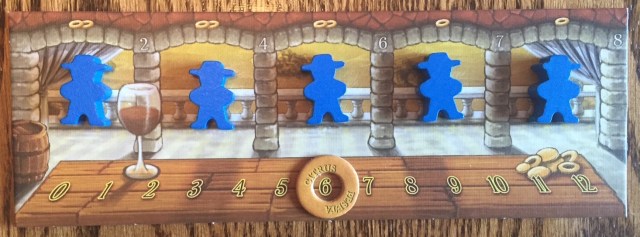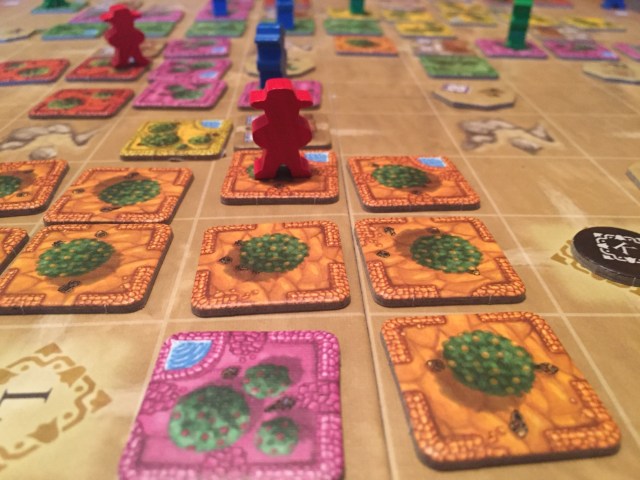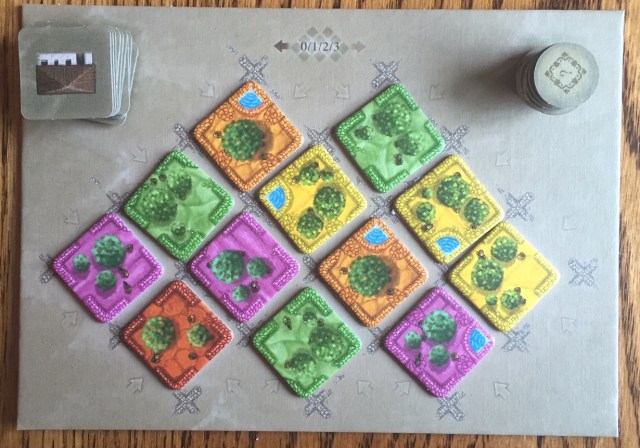- Designer: Jeffrey D. Allers
- Publisher: dlp games; TMG
- Players: 2 – 5
- Ages: 10 and Up
- Time: 60 Minutes
- Times Played: > 5

Note: The game’s designer, Jeff Allers, is a contributor to this site, but he did not participate in the review portion of what I’ve written below.
The second edition of Citrus was released at Essen last year, and I saw it when I stopped by the dlp booth to chat with the game’s designer, Jeff Allers. I flipped through the rulebook, and the game looked like something I’d enjoy, so I imported a copy from Germany. I’ve played it with a variety of groups since then, and it has been a hit with both my friends and family.
I was interested in reviewing the game, but I put the project on the backburner since Citrus didn’t have a U.S. release. But then, in late June, Miniature Market announced that it would begin importing more than 90 games from international publishers, and Citrus was one of the games on their list.
More importantly, Tasty Minstrel Games (TMG) has announced that they’ll be printing and releasing Citrus in the U.S. market.
Jeff told me that “Citrus was designed as a kind of throwback or homage to the classic tile-laying Eurogames that first introduced me to the hobby.” Jeff wrote a full Designer Diary at BoardGameGeek, which I highly recommend checking out. By way of update, in the Designer Diary, Jeff mentions that Citrus was one of three games that came out of him challenging Bernd Eisenstein to compete in a game design competition. They came up with three games: what would eventually become Citrus; what later became Alea Iacta Est (which was re-released at Gen Con as The Order of the Gilded Compass), and a game that was further developed into Phalanxx, which is being released by Bernd’s IronGames at Spiel this year. Jeff told me, “I never could have known that all 3 games we created for that simple challenge would eventually become published!”
As another interesting tidbit, Citrus received a mini-expansion at Essen called Citrus: Neue Landschaftsplättchen. As Jeff mentioned in the Designer Diary, at one point he was developing Citrus in parallel with Reiner Stockhausen. He noted that the version not ultimately used “still ended up spawning many of the bonus Landscape Tiles—including the ones from the expansion. Nothing is wasted!” He described these tiles both in the base game and the expansion as “rule breakers,” meaning “special tiles or cards that allow you—at key moments—to do special actions that are normally forbidden in the rules.” As you read the gameplay walkthough, you’ll see that this is the perfect description!
Gameplay Walkthrough
In Citrus, players buy and build citrus plantations, hoping to earn the most points over the course of the game through clever tile purchases and placements. Points are earned by (a) taking landscape tiles, (b) harvesting a plantation region, or (c) or by controlling the largest plantation regions adjacent to each Finca when it is scored.
The game board is double-sided. The short version of Citrus takes 30-40 minutes, and the long version takes 50-60 minutes. With 2-3 players, either version of the game works well, but the long version is recommended for 4-5 players.
Before the game begins, players shuffle the landscape tiles (which are explained below) and put them on the landscape spaces on the game board. The building site tiles are shuffled and placed in a face-down stack, and then three are flipped up and put on the appropriate spaces on the game board. The plantation market board—where players buy their tiles— is filled. Lastly, each player chooses a color and takes a player mat, 6 workers in their color, and their money marker. One of the works is placed along the score track. The remaining works are put in the spaces on the player board, and the money marker goes on the 6-coin space. The player that can best dance the Flamenco begins.

A player has a choice between two actions on his turn:
(1) Build plantations. The player first buys plantations from the market and then immediately builds them, paying one coin per plantation tile built. He immediately builds all of the plantations he bought; storing them is not an option. If he cannot pay for or build plantations in a row, he cannot buy that row.
(2) Harvest. A player scores a plantation region and collects income. Each tile harvested awards one point, but a tile with a well gives two points. The worker from the harvested region is placed back in the left-most free space on the player mat, and the player takes income as shown on the space to the right of where his worker was placed. The more workers a player has on his board, the more income he earns by harvesting.
Additionally, a player may perform special actions by using their landscape tiles at any time during their turn.

Players building tiles must follow certain placement rules. They can place a tile (a) adjacent to a matching plantation that is part of their own region, or (b) start a new region by placing on one of the roads leading from a Finca. When starting a new region, a player takes the right-most worker from their player mat and puts it on their region. (When expanding a region, placing further workers is unnecessary.) Rocks and construction sites (i.e. the sites of future Fincas) are off limits, and each road leading from a Finca must have a different color of plantation.
Players can merge their own regions, which results in the return of a worker. They may also merge their region with neutral ones (i.e. previously-harvested regions), provided the player’s region is at least as large as the neutral one pre-merger.
Players will occasionally build over landscape tiles, in which case they take the tile. The Wild Horses tiles award bonus points at the end of the game and are placed face down. The other tiles are action tiles and are placed face up. These can be used once each at any point during the player’s current turn or future turns.
The following action tiles come with the base game:
(1) Money. Immediately add the amount of coins shown to the player’s money track.
(2) Cart. The player may take any one plantation tile from the market for free and build it.
(3) Bull. The player can use the Bull to trigger a Finca scoring (discussed below) if other adjacent fields to the Finca are already occupied. The Bulls are the only tile that remain in the game after use: they can be picked up and re-used.
(4) Bridge. The player may build over a rock space or neutral plantation.
(5) Milestone. Build a Finca. Draw a Finca tile from the stack and build it on one of the possible building sites. Then replenish the market and draw a new building site tile and place it on the correct space.
Fincas are scored as soon as they are surrounded. Players add up their regions surrounding the Finca (including diagonally), and the player with the most regions gets the larger number on the Finca. The player with the second most gets the smaller number. All other players receive nothing. In the event of a tie, players will receive the same number of points, taking the full number for first place (and no players get points for second place) or second.
If there are ever three plantation tiles or fewer in the market, the player that caused this (a) draws a Finca and builds it, (b) builds his plantations, and then (c) refills the plantation market. After the new Finca is built, a new building site tile is drawn and placed on the appropriate space.

The game ends when all of the plantation tiles have been built. At that point, all of the Fincas are scored, with the first place player getting the smaller number printed (i.e. the number the second place player would normally get). All plantations that still have workers are harvested for points, and points are awarded for landscape tiles. The player with the most points wins!
My Thoughts on the Game: Citrus Adds Zest to the Tile Placement Genre
As I mentioned above, Jeff said “Citrus was designed as a kind of throwback or homage to the classic tile-laying Eurogames that first introduced me to the hobby.” I love that description, because that’s exactly how Citrus feels to me: it feels like a clever twist on the tile placement classics. I’d describe it as a great game for those seeking something deeper than Carcassonne yet more approachable than Tigris & Euphrates.
Citrus is a game of interesting decisions. While the first decision each turn seems simple — build or harvest — that decision is tougher than you’d initially expect. To a beginner, harvesting is a good choice if (1) there are no tiles you want in the market, or (2) you are out of cash. But because income is tied to the player’s number of workers on the board, the decision is tougher than that: everyone must balance their desire for points (earned by having workers on the board) with gaining income to fund future construction (since you earn less income the more workers you have out).
Ultimately, though, the challenging decision is what to build and where to build. I love the mechanism for selecting tiles: it was a fresh but simple way to add some depth to the design. Choosing where to place tiles can feel like a puzzle, but it isn’t overly complicated — the decision space is constrained by the board — and turns are relatively fast. The landscape tiles spice up gameplay, and it is fun to build plantations to target getting them.
Citrus has beautiful components and an attractive game board, and it is fun to watch the colors pop as the game progresses. The materials are high-quality, and the meeples are even cooler than those in Carcassonne. The player boards make gameplay more intuitive, and the rulebook is especially well-written. Citrus can be taught in under five minutes, but a beginner could quickly pick up the game because the rulebook is so well organized.
I think the game works best at low player counts. I don’t have a preference for the short game or the long game — even the long game can be played in less than an hour. But I think Citrus really shines at low player counts, and that’s how I prefer to play it. I’ve read/heard comments that the game is best with two, but my favorite player count is three. With four or five it can feel like you don’t get enough turns, and with two I don’t find there to be enough competition for the Fincas, but with three, the game is awesome.
I love Citrus. It feels like a well-developed, streamlined game full of interesting decisions, showing many of the hallmarks of great German game design. It has been a big hit with my family and friends. Congratulations to Jeff and dlp on creating a great game, and on the reprinting, a rare achievement in today’s market. While my game group still prefers Piece o’ Cake, this is my favorite Jeff Allers design. Some tile placement games can be a bit dry, but Citrus really adds zest (pun intended) to the genre.
Thoughts from Other Opinionated Gamers
Dan Blum: I like this a lot, and would definitely have acquired a copy already if it were easier to get in the US. The game has interesting constraints on both tile placement and on how long you can keep your workers active on the board, which together make this feel Knizia-esque. Since I like many of Knizia’s designs, that’s a recommendation.
Ratings from the Opinionated Gamers
- I love it! Chris Wray, Dan Blum
- I like it. Craig V, Mark Jackson
- Neutral.
- Not for me…

Pingback: Citrus (Game Review by Chris Wray) - eJouer.info eJouer.info
I think I’ll be requesting Citrus for Christmas. This based on the combination of “tile-laying” and “Knizia-esque”, among other things. Thanks for the review!
Pingback: Gunkimono (Game Review by Chris Wray) | The Opinionated Gamers